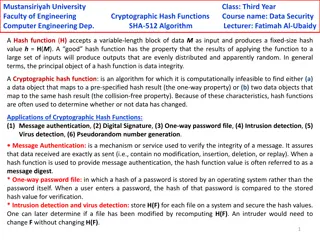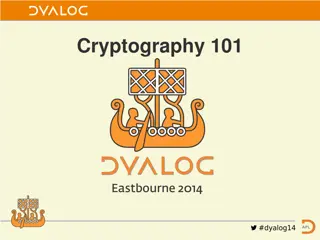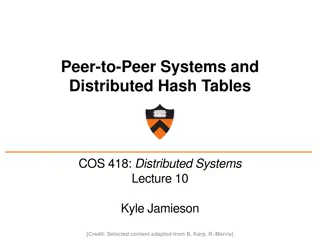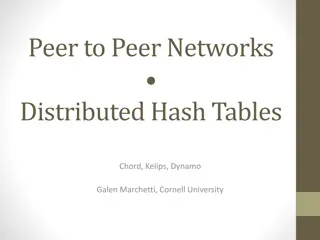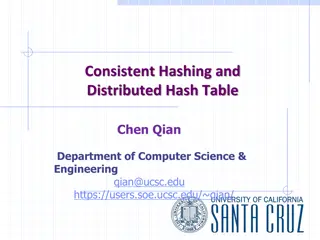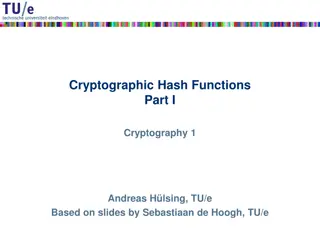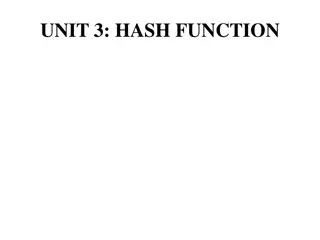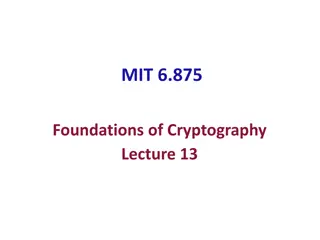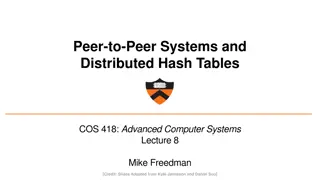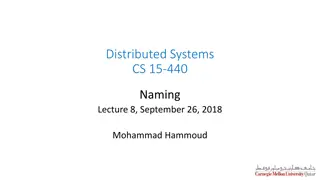Understanding Distributed Hash Tables in Peer-to-Peer Systems
Distributed Hash Tables (DHTs) are a fundamental component in organizing nodes in peer-to-peer networks. By using hash functions to assign keys to peers, DHTs enable efficient storage and retrieval of objects. Peers in a DHT are responsible for storing and managing key-value pairs, with each key being converted to an integer identifier. Assigning keys to peers based on the closest identifier allows for effective data retrieval. Circular DHTs, with or without shortcuts, optimize the network structure to reduce message overhead and enhance query resolution. Additionally, handling peer churn is essential for maintaining network stability.
Download Presentation

Please find below an Image/Link to download the presentation.
The content on the website is provided AS IS for your information and personal use only. It may not be sold, licensed, or shared on other websites without obtaining consent from the author. Download presentation by click this link. If you encounter any issues during the download, it is possible that the publisher has removed the file from their server.
E N D
Presentation Transcript
Distributed Hash Table A common approach is to use a Distributed Hash Table (DHT) to organize nodes Traditional hash functions convert a key to a hash value, which can be used as an index into a hash table. Keys are unique Each represents an object to store in the table The hash function value is used to insert an object in the hash table and to retrieve it.
Distributed Hash Table (DHT) DHT = distributed P2P database Database has (key, value) pairs; key: ss number; value: human name key: content type; value: IP address Peers query DB with key DB returns values that match the key Peers can also insert (key, value) peers
DHT Identifiers Assign integer identifier to each peer in range [0,2n-1]. Each identifier can be represented by n bits. Require each key to be an integer in same range. To get integer keys, hash original key. eg, key = h( Led Zeppelin IV ) This is why they call it a distributed hash table
How to assign keys to peers? Central issue: Assigning (key, value) pairs to peers. Rule: assign key to the peer that has the closest ID. Convention in lecture: closest is the immediate successor of the key. Ex: n=4; peers: 1,3,4,5,8,10,12,14; key = 13, then successor peer = 14 key = 15, then successor peer = 1
Circular DHT (1) 1 3 15 4 12 5 10 8 Each peer only aware of immediate successor and predecessor. Overlay network
Circle DHT (2) 0001 O(N) messages on avg to resolve query, when there are N peers Who s resp for key 1110 ? I am 0011 1111 1110 0100 1110 1110 1100 0101 1110 1110 Define closest as closest successor 1110 1010 1000
Circular DHT with Shortcuts 1 Who s resp for key 1110? 3 15 4 12 5 10 8 Each peer keeps track of IP addresses of predecessor, successor, short cuts. Reduced from 6 to 2 messages. Possible to design shortcuts so O(log N) neighbors, O(log N) messages in query
Peer Churn 1 To handle peer churn, require each peer to know the IP address of its two successors. Each peer periodically pings its two successors to see if they are still alive. 3 15 4 12 5 10 8 Peer 5 abruptly leaves Peer 4 detects; makes 8 its immediate successor; asks 8 who its immediate successor is; makes 8 s immediate successor its second successor. What if peer 13 wants to join?
SYNCHORNIZATION CLOCK SYNCHRONIZATION
Motivation Why clock synchronization matters? Control access to a single, shared resource Agree on the ordering of events Time-based computations on multiple machines Many applications require that clocks advance at similar rates Real-time scheduling events based on processor clock Setting timeouts and measuring latencies
Synchronization Synchronization within one system is hard enough Messages Semaphores, Monitors, Barriers, Synchronization among processes in a distributed system is much harder Two approaches to achieve synchronization Synchronization based on physical time Synchronization using relative ordering rather than absolute time
Clock Synchronization In a centralized system, time is unambiguous In a distributed system, achieving agreement on time is hard It is impossible to guarantee that independent physical clocks are fully synchronized Lack of a single global time source can cause errors
SYNCHORNIZATION PHYSICAL CLOCKs
Clock Synchronization Actual Time For time dependent applications the actual time is important External physical clocks become critical For efficiency and redundancy, multiple physical clocks are needed Two issues arise: 1. How to synchronize the physical clocks with real-world clocks? 2. How to synchronize these clocks with each other?
Time Measurement Atomic clocks make it possible to measure time accurately Several laboratories, equipped with Cesium 133 clocks, periodically report the number of times their clock has ticket to the Bureau International de l Heure (BIH) BIH computes the average to produce the International Atomic Time (TAI), the number of seconds since 01/01/1958 midnight divided by 9,192,631,370 TAI seconds are of constant length, unlike solar seconds. As the mean solar day is getting longer, TAI get out of synch Now, 86,600 TAI seconds are about 3 msec less than a mean solar day
Physical clocks Computer Clocks are acutually Timers, a precisely machined quartz crystal When kept under tension, crystals oscillate at a known fixed frequency Associated with the crystal are two registers, a counter and holding register At each oscillation, the counter decrements by 1 When counter reaches zero, an interrupt is generated Each interrupt corresponds to a clock tick Timers have manufacturing defects On a single node a clock being slightly off is tolerable With multiple nodes clock skew is problematic
Dealing with drift Set computer to true time Generally not good idea to set clock back Software can get very confused Gradual clock correction If fast then make clock run slower until it synchronizes If slow then make clock run faster until it synchronizes
Compensating for a fast clock ?? ?? > 1 Computer s time, C Clock Synchronized skew Linear Compensating Function Applied UTC time, t
Compensating for a fast clock Computer s time, C ?? ?? < 1 UTC time, t
SYNCHORNIZATION Network Time Protocol
Network Time Protocols Clients contact a time server for synchronization, Time server is typically equipped with an accurate time source client server Request () Reply(Crnt_Time) Does not account for processing and communication delay Delay Approximation
Network Time Protocol Getting the current time from a time server.
NTP Skew Assume delay is nearly symmetric Offset estimation = [(T2 T1) + (T3 T4 )]/2. If < 0 then clock must be set backward Not advisable Change must be introduced gradually, until the correction is made
NTP Basic Operation NTP is set up pairwise A probes B for its current time and B also probes A Compute the offset, , and the delay estimation, = (T4 T1) - (T3 T2 ) Buffer 8 pairs of ( , ), and select the minimal value for as the best delay estimation between the two servers The associated with the minimal delay is the most reliable estimation of the offset
NTP Hierarchy NTP divides servers into strata Strata-1 Servers Servers with a reference clock Clock itself is said to operate at stratum 0
SYNCHORNIZATION Berkeley Protocol
The Berkeley Algorithm Request For systems where no machine has an accurate time source The time daemon asks all the other machines for their clock values.
The Berkeley Algorithm Reply The machines answer with their current time Daemon computes the average of the received answers
The Berkeley Algorithm (3) The time daemon tells everyone how to adjust their clock. Speed up or jump ahead Slow down






